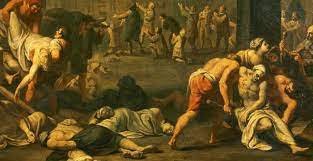One of the worst pandemics in human history was the Black Death, often known as the bubonic plague. Early in the thirteenth century, it began in China and expanded via trade routes to Europe, Africa, and Asia. The illness was brought on by the bacteria Yersinia pestis, which was spread to people by fleas found on rats. There was a massive population drop in Eurasia as a result of the Black Death’s fast spread, which claimed the lives of between 75 and 200 million people. Every area of society, including the economics, culture, and religion, was affected by the Black Death.
| No. | Spread | Year | Impact | Consequences |
| 1 | Asia | 1331-1334 | Kills millions of people, devastates economies | Trade routes disrupted, labor shortage |
| 2 | Crimea | 1343 | Spreads to Mediterranean via Italian merchants | Rise of anti-Semitism, persecution of Jews |
| 3 | Europe | 1347-1351 | Kills an estimated 25 million people | Labor shortage, social unrest, decline of feudalism |
| 4 | Africa | 1347-1351 | Kills millions of people | Shift in balance of power, rise of new states |
| 5 | Middle East | 1347-1351 | Kills millions of people | Rise of Islamic fundamentalism, political turmoil |
| 6 | Russia | 1351-1353 | Kills a third of the population | Centralization of power, serfdom |
| 7 | China | 1353-1354 | Kills millions of people | End of Yuan dynasty, rise of Ming dynasty |
| 8 | Italy | 1374 | Outbreak of “Dancing Plague” | Belief in supernatural causes of disease |
| 9 | England | 1377 | Parliament passes Statute of Laborers | Social unrest, rebellion |
| 10 | Europe | Late 14th c. | Flagellants roam countryside | Rise of religious extremism, public penance |
| 11 | Europe | 1397 | University of Paris opens medical faculty | Recognition of need for trained physicians |
| 12 | Europe | 15th c. | Contributes to decline of feudalism | Rise of money economy |
| 13 | Europe | 16th c. | Renaissance art reflects trauma of Black Death | Themes of death and mortality in art |
| 14 | Europe | 17th c. | Plague doctors become common sight | Development of public health policies |
| 15 | Global | Today | Legacy continues to shape public health policies | Ongoing research into infectious diseases |
| 15 | Cyprus | 1347 | Killed one-third of the population | Weakened the island’s economy |
| 16 | Sicily | 1347 | Killed half the population | Led to economic collapse |
| 17 | North Africa | 1347 | Killed large numbers of people, weakened economy | Created political instability |
| 18 | Egypt | 1347 | Killed a large portion of the population | Weakened the country’s military |
| 19 | Palestine | 1347 | Killed thousands of people | Led to a decline in the region’s agriculture |
| 20 | Syria | 1347 | Killed large numbers of people, weakened economy | Created political instability |
| 21 | Turkey | 1347 | Killed large numbers of people, weakened economy | Created political instability |
| 22 | Russia | 1351 | Killed a large portion of the population | Contributed to the decline of the Mongol Empire |
| 23 | Sweden | 1350s | Killed a third of the population, weakened economy | Led to social and economic changes |
| 24 | Ireland | 1348 | Killed around a third of the population, weakened economy | Contributed to the country’s political instability |
| 25 | Scotland | 1349 | Killed a large portion of the population | Contributed to political instability and economic decline |
| 26 | England | 1348-50 | Killed a third of the population, weakened economy | Led to changes in labor practices and social structure |
| 27 | Wales | 1349 | Killed a large portion of the population | Contributed to political instability and economic decline |
| 28 | Norway | 1349 | Killed a large portion of the population | Contributed to political instability and economic decline |
| 29 | Denmark | 1350 | Killed a large portion of the population | Contributed to political instability and economic decline |
| 30 | Finland | 1350s | Killed a large portion of the population | Contributed to political instability and economic decline |
| 31 | Scandinavia | 1350s | Devastating impact on population and economy | Loss of nearly 50% of population in some regions; long-term economic decline and social upheaval |
| 32 | Scotland | 1350s | Loss of up to 50% of population | Economic disruption, social unrest, and political instability |
| 33 | Poland | 1349-50 | Widespread death and population decline | Economic and social upheaval; weakening of the monarchy and nobility |
| 34 | Lithuania | 1349-50 | Massive population decline | Economic and social disruption; weakening of the monarchy and nobility |
| 35 | Russia | 1350s | Significant population loss and economic impact | Weakening of centralized power and increased local autonomy |
| 36 | China | 1331-1353 | Massive death toll and social upheaval | Significant demographic and economic consequences; end of the Yuan dynasty |
| 37 | India | 1347-1351 | Millions of deaths and major social upheaval | Decline of the Delhi Sultanate and regional states; social and economic changes |
| 38 | Middle East | 1340s | Widespread mortality and population loss | Significant economic disruption and social change; weakened empires and dynasties |
| 39 | North Africa | 1340s | Population loss and economic decline | Political and social instability; weakened Islamic dynasties |
| 40 | Western Europe | 1350s | Significant demographic and economic impact | Widespread social and religious upheaval; emergence of new social and economic structures |
| 41 | Eastern Europe | 1350s | Massive population loss and economic disruption | Weakening of centralized power and emergence of new social and economic structures |
| 42 | Mediterranean Basin | 1340s | Major demographic and economic impact | Significant social and political instability; weakening of empires and dynasties |
| 43 | Iberian Peninsula | 1340s | Widespread death and economic decline | Political and social instability; weakening of monarchies and emergence of new social and economic structures |
| 44 | British Isles | 1340s | Significant population loss and economic decline | Political and social instability; emergence of new social and economic structures |
| 45 | Scandinavia | 1349-50 | Devastating impact on population and economy | Loss of nearly 50% of population in some regions; long-term economic decline and social upheaval |
| 46 | Italy | 1347-50 | Massive death toll and economic impact | Widespread social and political instability; weakening of Italian city-states and emergence of new social and economic structures |



